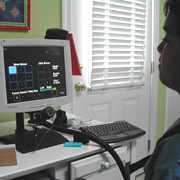CIS Professor Helps Children Thrive Artistically

For years researchers have worked on technologies to allow children with severe disabilities to use their eyes to reach out and communicate with those around them, to express basic human needs and desires that would otherwise remain locked inside their heads. The UO is moving towards a future where many such children are able to express themselves artistically as well. Professor Anthony Hornof and his students have has already developed EyeDraw, a software package that allows children to draw pictures with their eyes, and is now hoping to move into music.
In December, Prof Hornof was awarded $140,000 from the National Science Foundation's Universal Access program as a one-year Small Grant for Exploratory Research grant. The grant titled Collaborating with Children with Severe Disabilities in the Design of Eye-Controlled Software will look at the general problem of providing a rich set of eye-activated virtual control mechanisms, focusing primarily on software that produces music. The grant is also leading-edge because it seeks to incorporate the children into the design process as users, testers, informants and design partners. Hornof said, "With this funding, we will be able to collaborate with a local care facility for children with disabilities. One of the most challenging aspects of the project is to work as closely as possible with children who are the intended users of the system."
Before receiving the NSF award, Hornof's team had already done some work in the field of music. Last summer, the team hosted an EyeMusic concert in Deschutes Hall. As the program goes forward, the emphasis will be developing an intuitive interface that is usable by young children. "EyeDraw has been downloaded and used all over the world." said Hornof, "This new project will enable us to explore other creative activities for children with disabilities, such as making music with the eyes, or telling stories with the eyes."